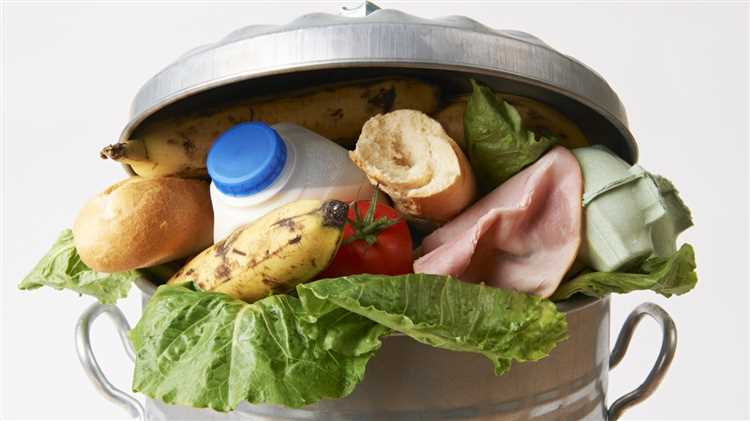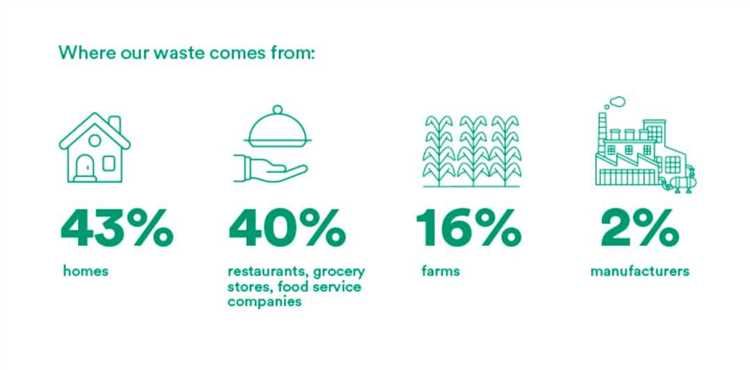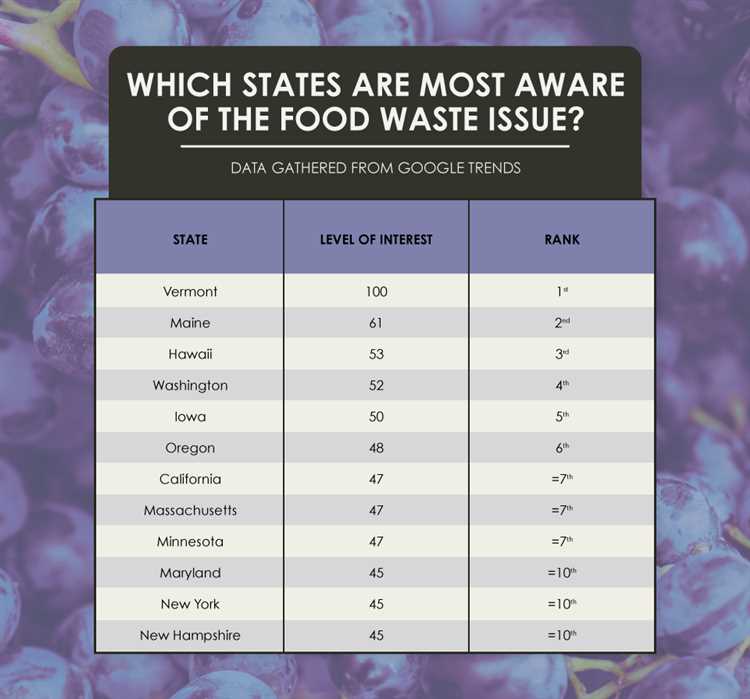
Food waste is a major problem not only in the United States but also globally. According to recent studies, about one-third of all food produced around the world is wasted, amounting to approximately 1.3 billion tons of food per year. This waste has significant economic, social, and environmental implications. It is not only a waste of resources but also contributes to greenhouse gas emissions and exacerbates hunger and food insecurity.
While food waste occurs at different stages of the supply chain, including production, distribution, and consumption, it is crucial to identify the regions or states within a country that are particularly prone to food waste. In the United States, one state stands out for its high levels of food waste: California.
California, often referred to as “The Golden State,” is known for its abundant agricultural production and diverse culinary scene. Unfortunately, it is also the state that wastes the most food. The reasons behind California’s high food waste levels are manifold. Firstly, the state’s large population and bustling cities generate a significant amount of food waste through residential and commercial sources. Secondly, California’s agricultural industry, which is responsible for a substantial portion of the state’s economy, also contributes to food waste due to factors such as imperfectly shaped produce being discarded.
Efforts to combat food waste in California have been increasing in recent years, with initiatives aimed at reducing waste, redistributing surplus food to those in need, and promoting sustainable practices. However, there is still a long way to go in tackling this issue effectively. By raising awareness, implementing stricter regulations, and encouraging individuals and businesses to adopt more responsible consumption habits, California and the rest of the United States can make significant progress in reducing food waste and creating a more sustainable food system.
- The Scale of Food Waste
- Food Waste in the United States
- The Environmental Impact
- The Social and Economic Consequences
- Understanding the Impact
- The Economic Impact
- The Social Impact
- A State in Focus
- The Causes and Contributing Factors
- Efforts to Reduce Food Waste
- Frequently asked questions:
- Which US state wastes the most food?
- Why does California waste the most food?
- What are the consequences of food waste in California?
- What measures are being taken to reduce food waste in California?
- Are there any initiatives to raise awareness about food waste in California?
- Which US state wastes the most food?
- Why does California waste so much food?
The Scale of Food Waste

Food waste is a significant issue not only in the United States but around the world. It is estimated that globally, about one-third of the food produced for human consumption is wasted every year. This amounts to approximately 1.3 billion tonnes of food.
Food Waste in the United States
The United States is one of the biggest culprits when it comes to food waste. It is estimated that approximately 40% of the food produced in the country goes uneaten. This equates to about 63 million tonnes of wasted food annually.
Food waste occurs at every stage of the food supply chain, from production and processing to distribution and consumption. Despite being one of the wealthiest nations in the world, the United States faces significant challenges in dealing with food waste.
The Environmental Impact
Food waste has a major environmental impact. When food is wasted, all the resources that went into producing it are also wasted. This includes water, energy, and land. Additionally, when food decomposes in landfills, it produces methane, a potent greenhouse gas that contributes to climate change.
Furthermore, food waste contributes to deforestation and biodiversity loss. As more land is cleared for agriculture to meet the demand for food that eventually goes to waste, natural habitats are destroyed, and wildlife is displaced.
The Social and Economic Consequences
Food waste also has substantial social and economic consequences. While millions of people around the world suffer from hunger and malnutrition, food that could have been consumed is being thrown away. This highlights the inequality in the food system.
In addition, food waste costs the United States billions of dollars each year. Food that is wasted represents a loss of resources and money for both businesses and individuals. It also creates additional costs for waste management and disposal.
Efforts are being made to address the issue of food waste, both internationally and within the United States. However, it requires a collective effort from individuals, businesses, and governments to reduce food waste and create a more sustainable food system for the future.
Understanding the Impact
Food waste has a significant impact on both the environment and the economy. When food is wasted, it not only represents a loss of resources and labor, but it also contributes to greenhouse gas emissions and climate change.
One of the major concerns with food waste is the amount of energy and resources that are used in the production and distribution of food. When food is wasted, all of the resources that went into growing, harvesting, transporting, and packaging it are also wasted. This includes water, land, energy, and chemicals such as fertilizers and pesticides. By reducing food waste, we can conserve these valuable resources and reduce our overall environmental footprint.
Additionally, when food is thrown away, it ends up in landfills where it decomposes and produces methane gas. Methane is a greenhouse gas that is more potent than carbon dioxide in terms of its impact on climate change. By reducing food waste, we can help mitigate the release of methane gas and reduce our contribution to global warming.
The Economic Impact

Food waste also has a significant economic impact. When food is wasted, it represents a loss of money for consumers, farmers, and businesses. Consumers who waste food are essentially throwing away their hard-earned money. Farmers who produce food that goes to waste are not able to recoup the costs of production, and businesses that sell food that spoils or is thrown away lose out on potential profits.
In addition to the direct economic losses, food waste also leads to higher food prices. When food is wasted, there is less supply available, which drives up the demand and causes prices to increase. This can make it more difficult for low-income individuals and families to afford nutritious food, exacerbating issues of food insecurity and hunger.
The Social Impact
Food waste also has a social impact, as it exacerbates issues of food insecurity and hunger. While food is being wasted, there are millions of people around the world who do not have access to enough food to meet their basic needs. By reducing food waste, we can redirect these resources to help feed those in need and work towards a more equitable food system.
Furthermore, reducing food waste can also create opportunities for economic and social development. By implementing sustainable food waste management practices, such as composting and food recovery programs, we can create jobs in waste management and food redistribution industries. These jobs not only help to reduce food waste but also provide employment opportunities for individuals in need.
In conclusion, understanding the impact of food waste is crucial in order to address this issue effectively. By recognizing the environmental, economic, and social consequences of food waste, we can develop strategies and initiatives to reduce waste, conserve resources, and work towards a more sustainable and equitable food system.
A State in Focus
As we delve into the issue of food waste in the United States, it becomes evident that certain states bear a greater burden than others. One such state that stands out in this respect is California. Known for its vast agricultural production, California also leads the country in terms of food waste.
California’s position as a major agricultural hub contributes to its high levels of food waste. With a year-round growing season and a diverse range of crops, the state produces an abundance of food. However, this abundance also leads to a significant amount of food going to waste. From crops left unharvested to imperfect fruits and vegetables deemed unsuitable for sale, California’s agricultural industry generates a substantial amount of food waste.
In addition to the agricultural sector, California’s large population further exacerbates the issue of food waste. With over 39 million residents, the state faces the challenge of ensuring an adequate food supply for all. Unfortunately, this also means that a significant amount of food is being wasted due to spoilage, overstocking, and consumer habits.
To combat this issue, California has implemented various initiatives aimed at reducing food waste. These include partnerships with food banks and nonprofit organizations to redistribute surplus food, educational campaigns to raise awareness about the impact of food waste, and policies to encourage composting and recycling of food waste.
Despite these efforts, the problem of food waste in California remains a pressing issue. The state continues to grapple with finding sustainable solutions to reduce waste and ensure that no one goes hungry. As we shine a spotlight on California, it becomes clear that addressing food waste requires a multi-faceted approach that involves collaboration between government, industry, and individuals.
The Causes and Contributing Factors

There are several causes and contributing factors to the high food waste rates in the US state that wastes the most food. These factors include:
| 1. Oversupply and Overproduction | Due to the large-scale agriculture and industrial food production systems, there is an excess supply of food in the state. This oversupply leads to a higher likelihood of food waste as there is simply more food available than can be consumed. |
| 2. Inefficient Transportation and Distribution | The transportation and distribution of food in this state may not be optimized, leading to delays, spoilage, and damage. This inefficient system results in a significant amount of food being wasted before it even reaches consumers. |
| 3. Lack of Proper Storage and Preservation | Inadequate storage facilities and lack of proper preservation techniques contribute to food spoilage. Without appropriate storage conditions, food is more likely to go bad before it can be consumed. |
| 4. Consumer Behavior and Food Preferences | Consumer behavior plays a significant role in food waste. Wasting food due to personal preferences, buying more than one can consume, and improper meal planning are common reasons for food waste in this state. |
| 5. Lack of Education and Awareness | Many individuals in this state may not have sufficient knowledge or awareness about the impacts of food waste. Lack of education on proper storage, preservation, and understanding expiration dates contribute to higher rates of food waste. |
Addressing these causes and contributing factors will be crucial in reducing food waste and creating a more sustainable food system in the state that wastes the most food.
Efforts to Reduce Food Waste
Reducing food waste has become a top priority in the United States, as it not only affects the environment but also contributes to hunger and food insecurity. Several initiatives have been implemented to address this issue and promote more responsible consumption and production of food.
Educational Campaigns: Increasing public awareness about the importance of reducing food waste is essential in changing behaviors. Many organizations and schools have launched educational campaigns to teach individuals about the impact of food waste and provide practical tips on how to minimize it. These campaigns emphasize the value of planning meals, proper storage techniques, and making use of leftovers.
Food Recovery Programs: To prevent perfectly edible food from going to waste, many organizations have established food recovery programs. These programs involve collecting excess food from restaurants, catered events, and grocery stores, and distributing it to local soup kitchens, food banks, and other community organizations. This process not only helps feed those in need but also reduces food waste.
Policy Initiatives: Governments at various levels have implemented policies and regulations to encourage businesses and households to reduce food waste. Some initiatives include the promotion of food date labeling best practices, tax incentives for food donation, and penalties for businesses that excessively waste food. These policies aim to create a more sustainable and conscious culture regarding food consumption and waste.
Technology Solutions: Advances in technology have also played a significant role in reducing food waste. Innovative apps and platforms connect food businesses and individuals with surplus food to customers who can use it. These platforms enable the redistribution of excess food that would otherwise go to waste, combating food waste at both the commercial and consumer levels.
Collaboration and Partnerships: Addressing the issue of food waste requires a collective effort from various stakeholders. Collaboration between food producers, retailers, government agencies, and non-profit organizations is crucial in developing effective strategies and sharing best practices. Through partnerships, these entities can pool resources, knowledge, and expertise to tackle food waste comprehensively.
Consumer Engagement: Ultimately, it comes down to individual consumers’ actions to make a significant impact on reducing food waste. Engaging consumers through educational campaigns, social media initiatives, and community programs can encourage them to adopt sustainable practices, such as mindful shopping, proper food storage, and donating excess food.
Efforts to reduce food waste are ongoing, with the aim of building a more sustainable and efficient food system. Through a combination of education, policies, technology, and collaboration, progress is being made to minimize food waste, alleviate hunger, and protect the environment.
Frequently asked questions:
Which US state wastes the most food?
According to a recent study, the US state that wastes the most food is California. It produces the most agricultural products, and as a result, a large amount of food goes to waste.
Why does California waste the most food?
California wastes the most food due to its high agricultural production. The state produces a large amount of fruits, vegetables, and other agricultural products, and not all of it is consumed or distributed in a timely manner, leading to a significant amount of food waste.
What are the consequences of food waste in California?
The consequences of food waste in California are significant. Besides the obvious economic impact of wasted resources, there are environmental consequences as well. Food waste contributes to greenhouse gas emissions and wastes water and energy resources used in production. It also exacerbates issues of hunger and food insecurity.
What measures are being taken to reduce food waste in California?
In recent years, California has implemented various measures to reduce food waste. These include setting goals to reduce food waste by a certain percentage, promoting food donation programs, and encouraging composting and recycling of food waste. Some cities and organizations are also working on innovative solutions, such as using excess food to feed animals or converting it into biofuel.
Are there any initiatives to raise awareness about food waste in California?
Yes, there are several initiatives in California aimed at raising awareness about food waste. These include educational campaigns in schools and communities, partnerships with non-profit organizations to distribute excess food to those in need, and events and workshops that focus on reducing food waste at the consumer level. The aim is to change behaviors and attitudes towards food waste and promote more sustainable practices.
Which US state wastes the most food?
The state that wastes the most food in the US is California.
Why does California waste so much food?
There are several reasons why California waste so much food. One reason is the large agricultural sector in the state, which produces a significant amount of perishable food that can go to waste if not consumed or processed in a timely manner. Additionally, California has a high population and a culture where food is readily available and often taken for granted, leading to more food waste. Finally, inefficient food distribution and storage systems can also contribute to food waste in the state.